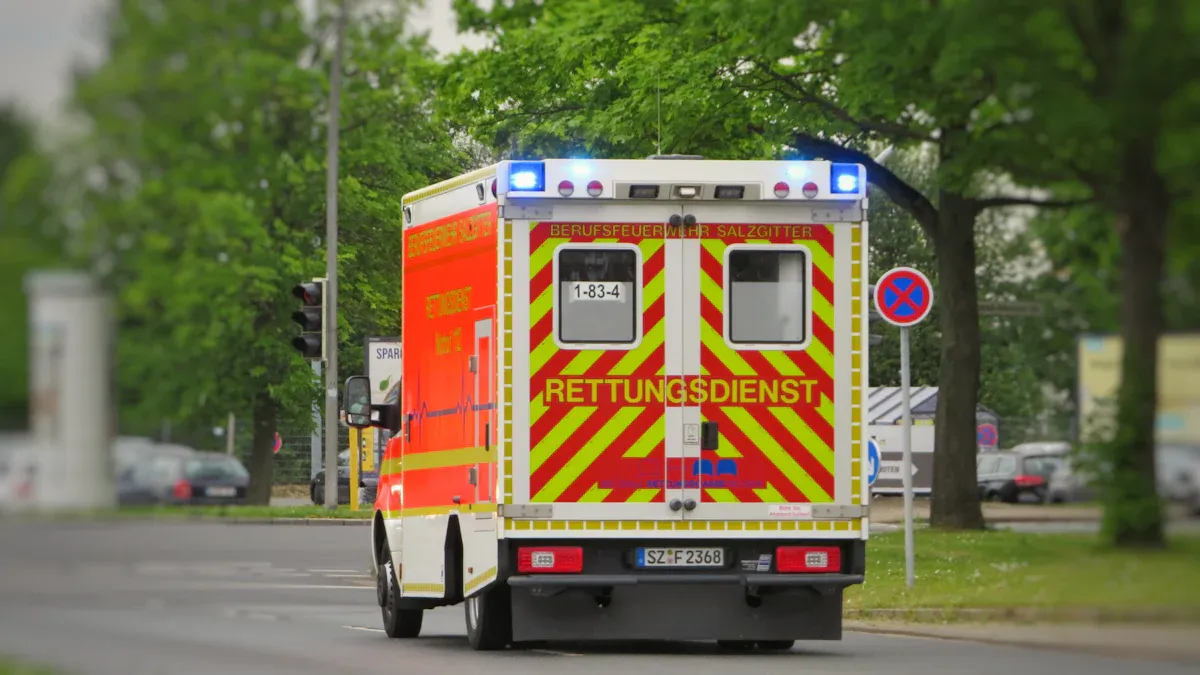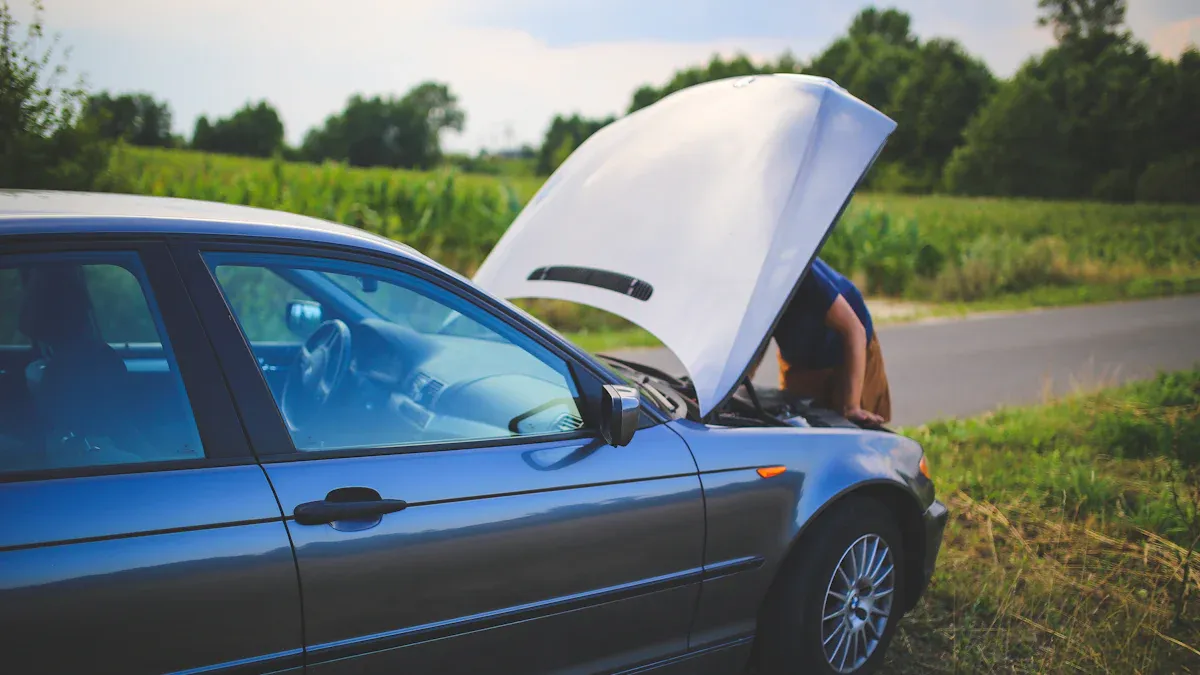
Roadside emergencies can happen unexpectedly, making effective use of roadside assistance services crucial for safety and peace of mind. The rising vehicle ownership and frequent breakdowns, such as flat tires or battery failures, highlight the growing need for these services. In 2024, the global roadside assistance market reached approximately USD 26.58 billion, with towing services accounting for over 32% of revenue. Staying informed and prepared reduces stress during emergencies. For instance, emergency responders report that understanding the situation beforehand significantly improves their ability to manage challenging scenarios. Simple steps, like using a traffic emergency telephone or a rugged emergency telephone, ensure timely assistance while keeping stress levels low. Additionally, having access to an industrial heavy duty telephone can be beneficial in more demanding environments, while a public outdoor telephone can provide a reliable communication option in open areas.
Understanding Roadside Assistance Coverage
Common Services Included in Coverage
Roadside assistance plans typically offer a range of services designed to address common vehicle issues. These services ensure drivers receive timely help during emergencies. Below is an overview of the most common services included in standard coverage:
| Service Type | Description |
|---|---|
| Towing | Transporting the vehicle to a repair location. |
| Tire Replacement | Changing a flat tire with a spare. |
| Fuel Delivery | Providing fuel when the vehicle runs out. |
| Jump Start | Starting a vehicle with a dead battery. |
| Lockout Services | Assisting with access when keys are locked inside. |
| Other Mechanical Assistance | Minor repairs on-site for mechanical issues. |
These services address a wide range of potential problems, ensuring drivers can get back on the road or reach a safe location.
How to Review Your Plan Details
Understanding the specifics of a roadside assistance plan is essential. Drivers should carefully review their policy documents to identify the services included. Key details to check include coverage limits, service availability, and any additional fees. For example, some plans may limit towing distances or charge extra for fuel delivery. Reviewing these details helps avoid surprises during emergencies. Contacting the service provider for clarification ensures a clear understanding of the plan.
Deciding When to Use Roadside Assistance
Knowing when to call for roadside assistance can save time and resources. Drivers should assess the severity of the issue before making a decision. For minor problems, such as a flat tire or a dead battery, roadside assistance is often the best option. However, for issues like running out of fuel near a gas station, resolving the problem independently may be quicker. Evaluating the situation ensures the most effective use of the service.
Staying Safe During Roadside Emergencies

Emergencies on the road can be unpredictable and dangerous. Staying safe requires quick thinking and adherence to best practices. Drivers and passengers must prioritize their safety while waiting for assistance.
Pulling Over Safely
Pulling over safely is the first step during a roadside emergency. Drivers should reduce speed gradually and move their vehicle to the shoulder or a safe area away from traffic. Avoid sudden braking or sharp turns, as these actions can increase the risk of accidents.
When choosing a location to stop, consider visibility and accessibility. Well-lit areas or locations with minimal traffic are ideal. If possible, park on a flat surface to prevent the vehicle from rolling. Always engage the parking brake after stopping.
Tip: If the vehicle breaks down on a highway, exit at the nearest ramp or rest area instead of stopping on the shoulder. This reduces exposure to high-speed traffic.
Using Hazard Lights and Warning Devices
Hazard lights and warning devices play a critical role in alerting other drivers to a roadside emergency. Activating hazard lights immediately after pulling over increases visibility, especially in low-light conditions or during inclement weather.
In addition to hazard lights, place warning devices such as reflective triangles or flares behind the vehicle. Position these devices at least 100 feet apart to provide ample warning to oncoming traffic. For highways, increase the distance to 200-300 feet.
| Warning Device | Recommended Use Case |
|---|---|
| Reflective Triangles | Daytime emergencies on busy roads |
| Flares | Nighttime or low-visibility conditions |
| LED Beacons | Long-lasting, reusable, and highly visible |
Note: Always place warning devices while facing oncoming traffic to maintain awareness of approaching vehicles.
Staying Inside Your Vehicle When Necessary
In certain situations, staying inside the vehicle is the safest option. Exiting the vehicle on a busy road or highway can expose individuals to high-speed traffic, increasing the risk of injury. Lock the doors and keep seat belts fastened while waiting for assistance.
However, exceptions exist. For instance, if the vehicle is at risk of catching fire or submerging in water, exiting becomes critical. Statistics show that vehicle submersion has the highest fatality rate among single-vehicle accidents. Annually, 350-400 people in North America lose their lives in submerged vehicles, accounting for up to 10% of all drownings. Most incidents are survivable if self-rescue actions are effective.
| Incident Type | Key Statistics |
|---|---|
| Vehicle Submersion | Highest fatality rate among single-vehicle accidents |
| Drowning Cases | 350-400 deaths annually in North America |
| Survival Rate | High if self-rescue actions are taken effectively |
Tip: If the vehicle begins to submerge, act quickly. Roll down the windows or break them using an emergency tool to escape.
By following these safety practices, drivers and passengers can minimize risks and ensure a safer experience during roadside emergencies.
Preparing for Roadside Emergencies
Essential Items for Your Emergency Kit
An emergency kit is a vital resource during roadside emergencies. Despite its importance, only 58% of U.S. drivers keep one in their vehicles, and 90% lack essential items. A well-stocked kit can mitigate risks and ensure preparedness. Key items include:
- Flashlight: Provides visibility during nighttime emergencies.
- Flat tire repair kit: Enables quick fixes for punctures.
- Tow strap: Assists in vehicle recovery.
- Fire extinguisher: Addresses small fires effectively.
- Water and non-perishable food: Supports hydration and sustenance.
- Multi-tool: Offers versatility for minor repairs.
- Reflective triangles and road flares: Enhance visibility to other drivers.
- Cell phone charger: Ensures communication during emergencies.
- Personal safety items: Includes gloves, masks, and first-aid supplies.
Drivers should familiarize themselves with these tools to maximize their utility during emergencies.
Tip: Store your emergency kit in an easily accessible location, such as the trunk or under a seat.
Importance of Regular Vehicle Maintenance
Regular vehicle maintenance plays a critical role in preventing roadside emergencies. Periodic inspections ensure that vehicles operate safely, reducing the likelihood of breakdowns. Maintenance tasks such as checking tire pressure, inspecting brakes, and replacing worn-out parts improve reliability. Research links consistent upkeep to enhanced roadside safety outcomes, benefiting both drivers and other road users.
Note: Schedule routine maintenance checks with a trusted mechanic to identify potential issues early.
Creating a Roadside Emergency Plan
A comprehensive emergency plan prepares drivers for unexpected situations. Safety experts recommend the following steps:
- Vehicle Maintenance: Conduct regular inspections to prevent mechanical failures.
- Emergency Contacts: Keep a list of roadside assistance and family members handy.
- Emergency Kit: Assemble essential tools and supplies.
- Knowledge of Tools: Learn how to use items in your kit effectively.
- Contingency Plan: Develop strategies for various scenarios, such as flat tires or engine failures.
- Basic Troubleshooting: Understand simple fixes for common issues.
- Recognizing Warning Signs: Address vehicle alerts promptly to avoid escalation.
Tip: Review your emergency plan periodically to ensure it remains relevant and up-to-date.
By preparing thoroughly, drivers can handle roadside emergencies with confidence and minimize risks.
Communicating Effectively with Service Providers
Using a Traffic Emergency Telephone or Smartphone
Effective communication during roadside emergencies begins with choosing the right device to contact service providers. A traffic emergency telephone, often located along highways, provides a reliable option for drivers in areas with poor mobile network coverage. These phones connect directly to emergency services, ensuring immediate assistance. Smartphones, on the other hand, offer versatility by enabling voice calls, text messages, and app-based communication. Mobile technology advancements, including 5G and IoT, enhance emergency response by improving connectivity and safety for road users.
Key technological innovations supporting roadside communication include:
- Mobile technology that enhances road safety and emergency response.
- Satellite technology providing accurate incident information in remote areas.
- Connected and automated vehicles (CAV) integrated with AI to improve road safety.
Tip: Drivers should familiarize themselves with the location of traffic emergency telephones along frequently traveled routes. This knowledge can prove invaluable during emergencies when smartphone connectivity is unavailable.
Providing Accurate Location Details
Precise location details are critical for ensuring timely assistance during roadside emergencies. Emergency responders rely on accurate data to navigate complex urban layouts or remote areas efficiently. Cellular technology, combined with 5G networks, significantly improves location accuracy, enabling responders to pinpoint incidents with precision. Properly configured networks further enhance this capability, reducing response times and potentially saving lives.
Drivers can provide accurate location details by:
- Using GPS-enabled devices to share real-time coordinates.
- Describing nearby landmarks, such as mile markers or exit signs.
- Utilizing roadside assistance apps with built-in location-sharing features.
Note: In areas lacking GPS coverage, drivers should use a traffic emergency telephone to communicate their location. These phones are strategically placed to assist responders in identifying the caller’s position.
Sharing Key Information About Your Vehicle and Issue
Providing detailed information about the vehicle and the nature of the issue helps service providers prepare the necessary tools and resources. Drivers should share the vehicle’s make, model, and color, along with a clear description of the problem. For instance, specifying whether the issue involves a flat tire, engine failure, or a dead battery allows responders to arrive equipped for the situation.
Effective communication strategies include:
| Strategy Type | Description |
|---|---|
| Omnichannel Communication | Enables individuals to communicate via voice calls, SMS, email, social media, and chat, ensuring accessibility during emergencies. |
| Speech Analytics | Analyzes customer interactions in real-time to prioritize urgent cases based on emotional tone. |
| Predictive Analytics | Anticipates call volumes and resource needs, allowing for proactive measures during emergencies. |
A streamlined digital intake process, as emphasized by Agero, ensures efficient service delivery. Continuous testing and iteration improve user experience, addressing challenges like identifying tow locations or processing payments. Drivers should also ensure their roadside assistance app is updated and easy to navigate.
Tip: Keep a list of essential vehicle details, such as the VIN and insurance policy number, in your glove compartment or smartphone for quick reference during emergencies.
Leveraging Technology for Faster Assistance

Benefits of Roadside Assistance Apps
Roadside assistance apps have revolutionized how drivers access help during emergencies. These apps simplify the process, allowing users to request assistance with just a few taps. They also provide real-time tracking, enabling drivers to monitor the service provider’s location and estimated arrival time. In metropolitan areas, this technology has reduced wait times to as little as 15-20 minutes, significantly improving response efficiency.
Beyond speed, these apps enhance transparency. Drivers can view upfront pricing estimates and service provider profiles, fostering trust and confidence. Secure payment options within the app eliminate the need for cash transactions, ensuring convenience and safety. Additionally, many apps offer a wide range of services, including towing, jump starts, and lockout assistance, making them a one-stop solution for roadside needs.
Tip: Popular apps like AAA Mobile and HONK provide 24/7 coverage and are equipped with features like real-time updates and GPS integration for precise location sharing.
How GPS Tracking Expedites Help
GPS tracking systems play a pivotal role in reducing wait times during roadside emergencies. These systems allow service providers to locate stranded vehicles quickly, ensuring timely assistance. Fleet managers can also monitor vehicle locations and estimated arrival times, streamlining the dispatch process. This capability minimizes delays and improves overall efficiency.
- GPS technology provides accurate location data, even in remote areas.
- It enables service providers to navigate traffic efficiently, reducing response times.
- Fleet tracking systems enhance coordination, ensuring resources are allocated effectively.
By leveraging GPS tracking, roadside assistance services can mitigate costly downtime and deliver faster, more reliable support.
Using Smartphone Features to Stay Connected
Smartphones offer a range of features that keep drivers connected during emergencies. Apps integrated with GPS enable precise location sharing, while real-time updates provide accurate arrival times for assistance. Transparent service reviews help users select reliable providers, ensuring quality service.
Navigation apps like Waze and SpotHero further enhance response times by offering traffic alerts and hazard warnings. Additionally, seamless communication with service providers through instant messaging or calls ensures immediate support. These features empower drivers to handle emergencies with confidence and efficiency.
Note: In areas with poor network coverage, drivers should locate a traffic emergency telephone to ensure uninterrupted communication with service providers.
Understanding roadside assistance coverage, staying safe, and preparing for emergencies are essential for effective use of these services. Regularly reviewing plans ensures readiness and aligns with the growing demand for reliable assistance:
- The market reached $31.9 billion in 2023 and will grow to $52.5 billion by 2033.
- Aging vehicles increase the need for professional support.
| Metric | Description |
|---|---|
| Response Time | Average: 28 minutes (Benchmark: Less than 30 minutes) |
| Customer Satisfaction | Score: 4.6/5 (Monitored via post-service surveys) |
Proactive preparation offers peace of mind, ensuring drivers can handle emergencies confidently.
FAQ
What should drivers do if their roadside assistance plan does not cover a specific service?
Drivers should contact their provider to confirm exclusions. If unavailable, they can seek local service providers or use apps like HONK for immediate help.
How can drivers ensure their emergency kit remains effective?
Drivers should inspect their kits every six months. Replace expired items, recharge batteries, and update tools to match seasonal needs or changes in vehicle requirements.
Are roadside assistance services available in remote areas?
Most providers offer coverage in remote areas. Drivers should confirm this with their plan and consider apps with GPS tracking for precise location sharing in such situations.


